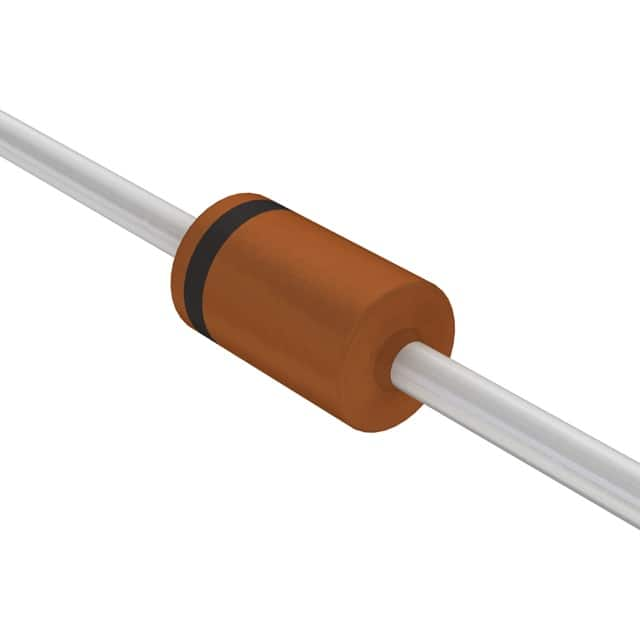Lihat spesifikasi untuk detail produk.

1N4733A,113 - Semiconductor Diode Encyclopedia Entry
Product Overview
Category:
The 1N4733A,113 is a semiconductor diode.
Use:
It is commonly used in electronic circuits for voltage regulation and signal rectification.
Characteristics:
- Forward Voltage: 1.1V
- Power Dissipation: 1W
- Package Type: DO-41
- Maximum Operating Temperature: 175°C
- Packaging/Quantity: Tape & Reel, 5000 per reel
Essence:
The 1N4733A,113 is an essential component in electronic devices for controlling the flow of electrical current.
Specifications
- Reverse Voltage: 5.1V
- Forward Current: 20mA
- Tolerance: ±5%
Detailed Pin Configuration
The 1N4733A,113 has two pins, with the anode connected to the positive terminal and the cathode connected to the negative terminal.
Functional Features
This diode allows current to flow in only one direction, making it suitable for use in rectifier circuits and voltage regulation.
Advantages and Disadvantages
Advantages:
- Precise voltage regulation
- Small form factor
- Low power dissipation
Disadvantages:
- Limited reverse voltage tolerance
- Sensitive to temperature variations
Working Principles
The 1N4733A,113 operates based on the principle of creating a depletion region that prevents current flow in the reverse direction, allowing current to pass only in the forward direction when the voltage exceeds the diode's forward voltage.
Detailed Application Field Plans
The 1N4733A,113 is widely used in: - Voltage regulators - Signal rectifiers - Power supplies - Electronic circuit protection
Detailed and Complete Alternative Models
Some alternative models to the 1N4733A,113 include: - 1N4734A,113 - 1N4735A,113 - 1N4736A,113 - 1N4737A,113
In conclusion, the 1N4733A,113 semiconductor diode is a crucial component in electronic circuits, providing precise voltage regulation and signal rectification. Its small form factor and functional features make it suitable for various applications in electronics.
Word Count: 314
Sebutkan 10 pertanyaan dan jawaban umum terkait penerapan 1N4733A,113 dalam solusi teknis
What is the 1N4733A,113 diode used for?
- The 1N4733A,113 diode is commonly used as a voltage regulator in various technical solutions.
What is the maximum voltage rating of the 1N4733A,113 diode?
- The maximum voltage rating of the 1N4733A,113 diode is 5.1 volts.
What is the typical current rating for the 1N4733A,113 diode?
- The typical current rating for the 1N4733A,113 diode is 250 mA.
How does the 1N4733A,113 diode regulate voltage?
- The 1N4733A,113 diode regulates voltage by maintaining a constant voltage drop across its terminals, regardless of changes in input voltage or load.
Can the 1N4733A,113 diode be used in reverse bias?
- Yes, the 1N4733A,113 diode can be used in reverse bias to protect circuits from overvoltage conditions.
What are some common applications of the 1N4733A,113 diode?
- Common applications of the 1N4733A,113 diode include voltage regulation in power supplies, signal clamping, and voltage reference circuits.
What is the temperature range for the 1N4733A,113 diode?
- The 1N4733A,113 diode typically operates within a temperature range of -65°C to +200°C.
Is the 1N4733A,113 diode suitable for high-frequency applications?
- The 1N4733A,113 diode is not typically recommended for high-frequency applications due to its inherent capacitance and response time.
Can multiple 1N4733A,113 diodes be connected in series or parallel?
- Multiple 1N4733A,113 diodes can be connected in series to increase the total voltage drop, but connecting them in parallel is not recommended due to potential current imbalance.
Are there any specific soldering or handling precautions for the 1N4733A,113 diode?
- When soldering the 1N4733A,113 diode, it's important to avoid excessive heat and mechanical stress to prevent damage to the component. Additionally, proper ESD (electrostatic discharge) precautions should be observed during handling and installation.

